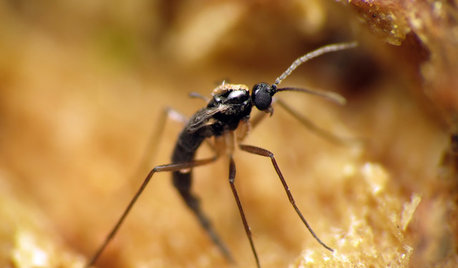Fungus gnats
rmontcal
11 years ago
Related Stories

LIFEHow to Get Rid of Gnats Around the House
See swarming bugs in your plants or garden? Focus on the health of the soil and be naturally pest-free
Full Story
MOST POPULARHow to Get Rid of Those Pesky Summer Fruit Flies
Learn what fruit flies are, how to prevent them and how to get rid of them in your home
Full Story
GARDENING GUIDESCommon Myths That May Be Hurting Your Garden
Discover the truth about fertilizer, soil, staking and more to keep your plants healthy and happy
Full Story
HOUSEPLANTSIndoor Winter Gardens for Cheerier Days
Bring plants inside for drab-days mood boosting — not to mention cleaner indoor air and protection for your greenery
Full Story
HOUZZ TOURSMy Houzz: LEDs and a Living Wall Color a Minimalist Slovakian Home
Thanks to a modern overhaul, this small Central European apartment is now a testament to efficiency and thoughtful design
Full Story
GARDENING 101How to Grow Tomatoes in Pots
Don’t have much space for a garden? All you need is a sunny spot and a large container to grow this favorite summer crop
Full Story
FALL GARDENING5 Ways to Put Fall Leaves to Work in Your Garden
Improve your soil and yard the organic way with a valuable garden booster that grows on trees
Full Story
FALL AND THANKSGIVINGFall Decorating Ideas From a Designer to the Stars
You might think all-out glitz and over-the-top glamour make up Adam Hunter's fall decorations. You'd be wrong
Full StorySponsored
Columbus Area's Luxury Design Build Firm | 17x Best of Houzz Winner!
More Discussions






DWD2
dan4279
Related Professionals
Eden Prairie Landscape Architects & Landscape Designers · Apollo Beach Landscape Contractors · Cerritos Landscape Contractors · Concord Landscape Contractors · Fair Lawn Landscape Contractors · Tinton Falls Landscape Contractors · Wethersfield Landscape Contractors · Lynwood Solar Energy Systems · Milpitas Solar Energy Systems · Wasco Solar Energy Systems · Dayton Window Contractors · Detroit Window Contractors · Compton Fence Contractors · Ellicott City Fence Contractors · Tacoma Fence ContractorsThe Ficus Wrangler
digdirt2
DWD2
DWD2
The Ficus Wrangler
greenman28 NorCal 7b/8a
DWD2
dan4279
greenman28 NorCal 7b/8a